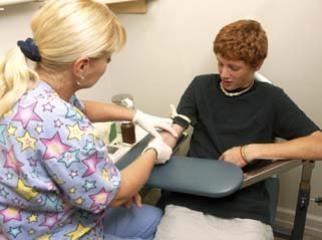Summary
Please enable javascript to play this video.
| Quick Facts: Phlebotomists | |
|---|---|
|
$43,660 per year
$20.99 per hour |
|
| Postsecondary nondegree award | |
| None | |
| None | |
| 139,700 | |
| 6% (Faster than average) | |
| 7,900 | |
What Phlebotomists Do
Phlebotomists draw blood for tests, transfusions, research, or blood donations.
Work Environment
Phlebotomists are employed in a variety of settings, including hospitals, medical and diagnostic laboratories, blood donor centers, and doctors’ offices.
How to Become a Phlebotomist
Phlebotomists typically enter the occupation with a certificate from a postsecondary phlebotomy program, but some qualify with a high school diploma and on-the-job training. Employers may prefer to hire candidates who have earned professional certification.
Pay
The median annual wage for phlebotomists was $43,660 in May 2024.
Job Outlook
Employment of phlebotomists is projected to grow 6 percent from 2024 to 2034, faster than the average for all occupations.
About 18,400 openings for phlebotomists are projected each year, on average, over the decade. Many of those openings are expected to result from the need to replace workers who transfer to different occupations or exit the labor force, such as to retire.
State & Area Data
Explore resources for employment and wages by state and area for phlebotomists.
Similar Occupations
Compare the job duties, education, job growth, and pay of phlebotomists with similar occupations.
More Information, Including Links to O*NET
Learn more about phlebotomists by visiting additional resources, including O*NET, a source on key characteristics of workers and occupations.
 United States Department of Labor
United States Department of Labor









